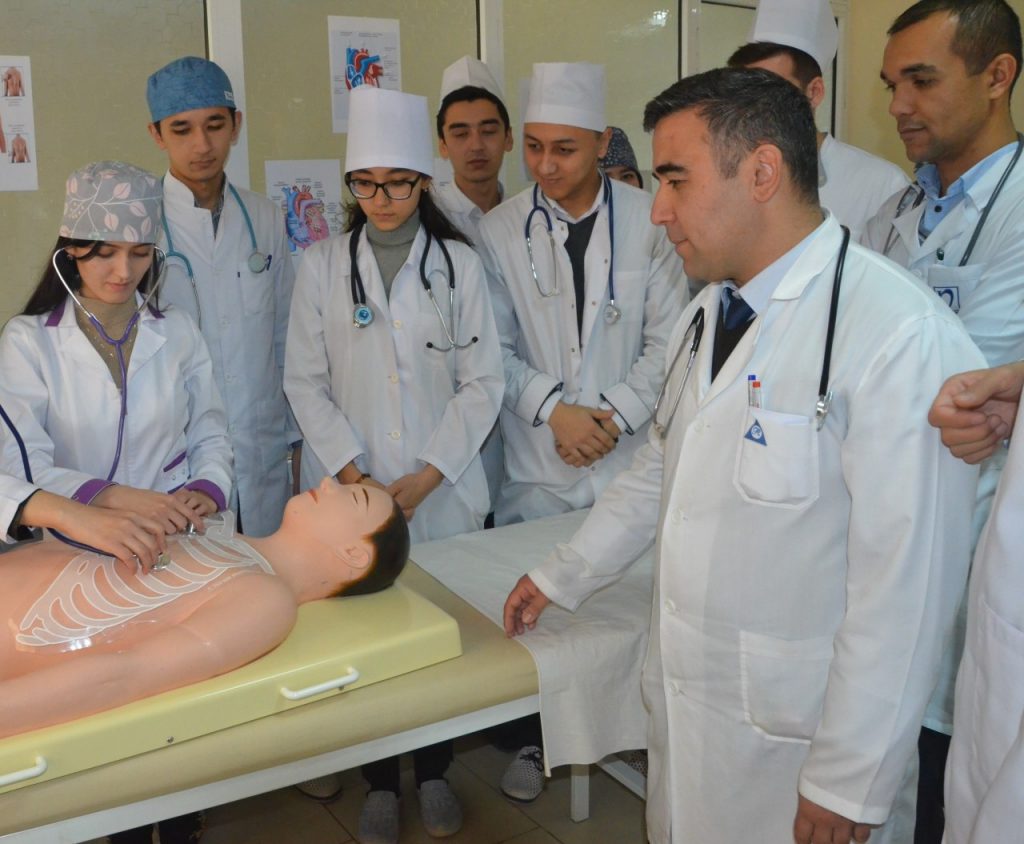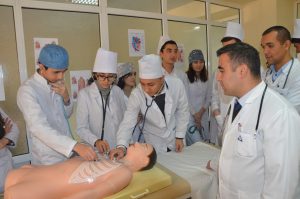
CALENDAR AND THEME PLAN
Department: Propaedeutics of internal diseases №1
Subject: Propaedeutics of internal diseases
Faculty: Medical Faculty №1
Course: II
Semester: IV
Hours allotted for the subject: 120 hours
Lecture: 10 hours
Seminar: 50 hours
Independent work: 60 hours
LECTURES
| № | Name of lecture | Hours |
| 1 | Introduction. The history of the development of internal medicine. National Schools of Physicians. Definition of the subject of propaedeutics of internal diseases. Targets and goals. The concept of semiotics (symptoms and syndromes). Medical deontology. Methods of clinical examination of patients. | 2 |
| 2 | Clinical and physical data with lung consolidation, bronchospastic syndrome, increased airiness of lung tissue, cavity formation syndrome in the lung and accumulation of air or fluid in the pleural cavity. | 2
|
| 3 | Examination of patients with diseases of the cardiovascular system. Heart sounds and murmurs, organic and functional murmurs. The main clinical symptoms and syndromes are pain in the region of the heart, hypertension, palpitations, shortness of breath, and oedema. Examination and diagnosis of patients with hypertension, risk factors, classification. | 2 |
| 4 | Atherosclerosis and its clinical manifestations. ischemic heart disease. Stable and unstable angina. Acute myocardial infarction. Laboratory and instrumental diagnostics. | 2 |
| 5 | Historical information about the ECG. Origin of biopotentials. The genesis of waves and intervals of an ECG. ECG leads. Disturbances of the function of automatism, pacemaker rate and conduction. ECG in angina pectoris and myocardial infarction. | 2 |
| Total | 10 | |
PRACTICAL LESSONS
| № | Name of practical lessons | hours | |
| 1 | Topic | The order of examination of the patient. The medical history diagram. Questioning: ID part, complaints (main and additional), history of the present disease (anamnesis Morbi), patient’s life history (anamnesis Vitae). History taking of patients according to the scheme, collection of the anamnesis with the teacher. Promotion of healthy lifestyles. Body mass index. Fever. Types of fever. Temperature curves. | 4
|
| IWS. | National Schools of Physicians. Deontology of the basis of communication. Temperature curves. | 3 | |
| Practical skills | Know the medical history diagram. | ||
| 2 | Topic | General examination of the patient (general status, consciousness, position, physique, constitution). The body parts inspection: head, face, ears, eyes, neck, skin, mucous membranes, subcutaneous fat, muscles, bones, joints, and lymph nodes. Examination of patients with a teacher. | 4
|
| IWS. | Body types. Constitution and physique | 3 | |
| Practical skills | Examination of patients | ||
| 3 | Topic | Methods of examination of patients with respiratory diseases. Main complaints (cough, hemoptysis, chest pain, inspiratory and expiratory dyspnea, dyspnea), anamnesis of the disease and life. Type, rhythm, depth and number of breaths. Inspection and palpation of the chest. Painful points, the elasticity of the chest, fremitus pectoralis. Examination of patients and writing a fragment of the case history. | 4
|
| IWS. | Anatomical and physiological features of the respiratory system. Respiration in normal and pathological conditions. | 3 | |
| Practical skills | Know how to determine BMI. General inspection and inspection in parts. | ||
| 4 | Topic | Percussion of the lungs. Comparative and topographic percussion in health person and patient (consolidation, accumulation of fluid and air, cavity). The apex of the lungs (width, height, Krenig fields), normal and pathological state. Excursion of the lungs in normal and pathological conditions. | 4
|
| IWS. | Borders of the lungs in normal and pathological conditions. Write 10 multiple questions choices. | 3 | |
| Practical skills | Define respiration rate. Examine and palpate the chest. Master the technique of comparative and topographic percussion of the chest in normal and pathological conditions. | ||
| 5 | Topic | Auscultation of the lungs: main (vesicular and bronchial breath sounds) and additional respiratory sounds (dry and wet rales, crepitus, pleural friction noise). Diagnostic value. | 4
|
| IWS. | Auscultation methods. | 3 | |
| Practical skills | Master the technique of auscultation of the lungs in normal and pathological conditions. | ||
| 6 | Topic | Broncho-obstructive syndrome. Examination and diagnosis of patients with acute and chronic bronchitis, COPD, bronchial asthma, and emphysema. Functional-instrumental methods for the study of patients with respiratory diseases: oximetry, picfloumetry, spirometry. Prevention. The principle of therapy. Examination and analysis of patients with a teacher. Bronchoscopy. Bronchography. CT, MRI. Analysis of the sputum, pleural fluid and radiographs. MQCH control. | 6
|
| IWS. | Indicators of oximetry and picfloumetry in normal and pathological conditions. Risk factors for the development of the broncho-obstructive syndrome. | 3 | |
| Practical skills | Interpretation of the data of oximetry, picfloumetry, x-ray studies, CT, MRI bronchoscopy, and bronchography of patients with respiratory diseases. | ||
| Curation of patients and writing a medical history. | Extra-lesson | ||
| 7 | Topic | Syndrome of consolidation of the lungs (seals). Examination and diagnosis of patients with croup and focal pneumonia. Laboratory examination of sputum. X-ray examination. The principle of therapy. Prevention. Examination and analysis of patients with a teacher. | 6
|
| IWS. | Writing 4 cases according to the topic.
The conduction system of the heart. ECG in standard, enhanced and chest leads are normal. ECG reading algorithm. |
3 | |
| Practical skills | Questioning and examination of patients with consolidation in the lungs (croup and focal pneumonia). Interpretation of sputum tests. | ||
| 8 | Topic | Syndrome of accumulation of fluid and air in the lungs. Examination and diagnosis of patients with pleurisy (dry and exudative). Examination of the pleural fluid. Hydrothorax and pneumothorax. Syndrome of the presence of a cavity in the lungs. Examination and diagnosis of suppurative lung diseases: bronchiectasis, lung abscess. Prevention. The principle of therapy. Examination and analysis of patients with a teacher. | 6
|
| IWS. | Presentation on the topic of the lesson. Analysis of pleural fluid in normal and pathological conditions. | 3 | |
| Practical skills | Interpretation of analyzes of pleural fluid in normal and pathological conditions. | ||
| 9 | Topic | ECG registration. Normal ECG in standard augmented and chest leads. ECG in atrial and ventricular hypertrophy. Reading an ECG. | 6
|
| IWS. | The conduction system of the heart. ECG in standard, enhanced and chest leads are normal. ECG reading algorithm. | 3 | |
| Practical skills | Able to read ECG in normal conditions and hypertrophy of the heart’s atria and ventricles. | ||
| 10 | Topic | Arrhythmias and blockades. Holter ECG. ECG in disturbance of the function of automatism, excitability and conduction. Reading an ECG. | 6
|
| IWS. | ECG with atrial and ventricular extrasystoles, and paroxysmal tachycardia | 3 | |
| Practical skills | Be able to read an ECG with arrhythmias (extrasystoles, paroxysmal tachycardia, blockades). | ||
| Total | 50 | ||





